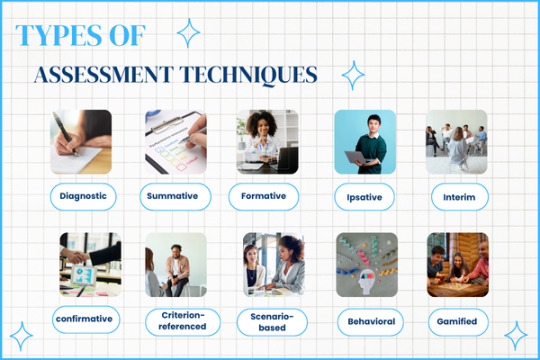#workplacelearning
Explore tagged Tumblr posts
Text

🧠 Master Assessment Techniques! Explore the essential assessment techniques that shape effective learning and performance evaluation. Whether you're in education, training, or HR, understanding these methods can elevate your impact. Save this visual for your toolkit! 📊✅
#typesofassessments#educationtools#learning strategies#teachingresources#study tips#EducationalInfographic#FormativeAssessment#SummativeAssessment#DiagnosticAssessment#IpsativeAssessment#EducationMatters#KnowledgeSharing#VisualLearning#LearningAndDevelopment#AssessmentStrategies#EducationalAssessment#SkillDevelopment#PerformanceReview#WorkplaceLearning#HRTraining#TrainingAndDevelopment
1 note
·
View note
Text
Why Application Training is the Secret to a More Productive Workforce?
Is your team using enterprise tools — or just surviving them?
In today’s digital-first workplace, businesses invest heavily in software. But what often gets overlooked? The human side of that investment — the actual training employees need to use these applications efficiently.
That’s where Application Training comes in.
From HR platforms to CRM tools, employees are expected to master complex applications almost overnight. Without structured guidance, this leads to frustration, errors, and costly downtime. The result? Your software investment doesn't pay off — and your teams struggle to keep up.
Effective application training bridges this gap by:
Delivering role-based learning tailored to specific job functions
Using microlearning, simulations, and interactive walkthroughs
Supporting continuous learning with self-paced modules
Application training is no longer a one-off onboarding task — it’s an ongoing strategy to boost productivity, reduce IT support requests, and help employees feel confident in their digital workspace.
🧠 Here’s the kicker: According to industry insights, companies that prioritize structured application training see a 30–50% improvement in employee efficiency. And when your team uses tools correctly, workflows speed up, errors drop, and performance metrics rise.
Want to unlock this kind of ROI in your business?
👉 Read the full blog here to explore how to design an application training program that works — with real strategies, formats, and success metrics.
0 notes
Text

Wondering who should attend our webinars? Are they just for one profession, or everyone?
At Course Ministry, we’re a workplace compliance platform designed to support the needs of a wide range of office-going professionals across industries.
Drop your profession in the comments, and we’ll recommend the webinars that are most relevant for you!
#WorkplaceCompliance#ProfessionalDevelopment#HRTraining#ComplianceWebinars#CareerGrowth#WorkplaceLearning
0 notes
Text
The 2025 Skills Gap: Are You Future-Ready?
72% of employers are struggling to find candidates with the right skills.
As industries evolve, new technologies and job roles demand more than just a degree. Employers are seeking adaptable, tech-savvy professionals who can bridge the skills gap — and fast.
In 2025, the most in-demand skills include:
Cybersecurity 🔐
Cloud Migration ☁️
Machine Learning 🤖
Big Data Analytics 📊
So… how do you stay ahead? ✔️ Understand your current skill set ✔️ Identify the gaps ✔️ Upskill with targeted training
🧠 Upskilling is not optional — it’s strategic. 👉 Check out how organizations are tackling this challenge

0 notes
Text
Training & Development Employees! This is the perfect Notebook for YOU.

I ❤️ Love T&D NOTEBOOK!

(As an Amazon Associate, I earn from qualifying purchases.)
#TrainingAndDevelopment#LearningAndDevelopment#L&D#CorporateTraining#EmployeeDevelopment#WorkplaceLearning
0 notes
Text
E-learning at Work: Transforming the Modern Workplace

Source: Image by Ivanko_Brnjakovic from Getty Images
Share Post:
LinkedIn
Twitter
Facebook
Reddit
Pinterest
The modern workplace presents employees with a changing world and is dynamic in structure. Modern-day competition requires a workforce with current knowledge and skills. Traditionally, training was not capable of keeping pace with the enormousness and intensity of change introduced in the modern workplace. So comes that time of e-learning at work, a process through which organizations are seeing a makeover in the ways their employees learn and fit into them. Flexibility and accessibility to learning opportunities are characteristics of this approach-prospective traits for better organizational careers.
The Rise of E-learning at Work
If the digital revolution has touched any aspect of our lives, learning must be one of them. Rather than being restricted to classrooms with tightly scheduled timetables, learning now flows in and out of work because of e-learning in the workplace. This is not just some trend but a complete overhaul of how organizations have approached employee development.
Digital platforms present an unparalleled range of experiences, from interactive lessons to training, game-based assessments, and virtuous classrooms. This flexibility enables organizations to set up learning programs aligned with specific needs and styles of learning to get the most out of their learning and engagement. The emergence of e-learning in the workplace corresponds to the need to provide training that is readily accessed and constantly updated.
Benefits of E-learning for Employees

E-learning puts employees in charge of their professional development. It is accessible where and when to learn, fitting perfectly within the packed schedules. The flexibility in learning time is useful, especially for remote workers and those who have several responsibilities. Furthermore, digital platforms frequently provide personalized learning paths so that the user can concentrate on areas to improve or expand their knowledge. This much-targeted skill development boosts employees’ motivation and job satisfaction. This illustrates that employees feel valued in organizations that invest in them through e-learning at work, translating to their retention and possibly an engaged workforce.
Read More: Learn these 11 Chapters to Navigate the Power of Diversity and Inclusion in the Modern Workplace
Benefits of E-learning at Work for Organizations
Besides individual benefits, e-learning also offers a great boon to the organization as a whole. One astounding benefit is cost-effectiveness. Compared to traditional training methods, e-learning at the workplace significantly reduces travel, accommodation, materials, and instructor fees. Another significant advantage of e-learning is scalable. A digital learning program can thus reach large numbers of employees at once, regardless of location.
Therefore, this makes e-learning fit for the induction of recruits, roll out of company-wide initiatives, or continuing professional development. Also, digital platforms furnish useful data and analytics, creating an overview of employee performance, helping to pinpoint knowledge gaps, and gauging the success of learning programs. All this data-oriented work allows for continuous upgrades and ensures that learning initiatives line up with business requirements.
Key Features of Effective E-learning at Work

Not all digital learning programs, or e-learning at work initiatives, are created equal. To maximize impact, organizations should focus on incorporating the following key features:
Engaging Content: Interactive modules, videos, simulations, and gamification can transform passive learning into an active and enjoyable experience.
Personalized Learning Paths: Tailoring learning content to individual needs and skill levels ensures relevance and maximizes knowledge retention.
Mobile Accessibility: Allowing employees to access learning materials on their mobile devices provides flexibility and encourages continuous learning.
Microlearning: Breaking down complex topics into bite-sized modules makes learning more manageable and digestible.
Social Learning: Incorporating collaborative elements, such as discussion forums and group projects, fosters peer-to-peer learning and knowledge sharing.
Assessment and Feedback: Regular assessments and feedback mechanisms help employees track their progress and identify areas for improvement.
Integration with Existing Systems: Seamless integration with existing HR and learning management systems streamlines administration and tracking.
Read More: Transform Your Workplace with Effective Office Space Planning
Implementing E-learning Successfully
Successfully implementing E-learning requires careful planning and execution. Organizations should:
Define Clear Objectives: Clearly articulate the goals of the learning program and how it aligns with business objectives.
Conduct a Needs Assessment: Identify the specific skills and knowledge gaps that need to be addressed.
Select the Right Platform: Choose a digital learning platform that meets the organization’s needs and budget.
Develop Engaging Content: Invest in creating high-quality, interactive learning materials.
Promote and Communicate: Effectively communicate the benefits of E-learning to employees and encourage participation.
Provide Support and Training: Offer support and training to employees on how to use the digital learning platform.
Measure and Evaluate: Track employee progress and evaluate the effectiveness of the learning program.
Read More: A Deep Dive into Corporate Wellness Programs for a Healthier, Happier Workplace
The Future of E-learning at Work

The evolution of E-learning continues. It is fast progressive with the introduction of new aspects of technology and approaches. Besides these technologies, other technologies on the verge of revolutionizing the learning method include artificial intelligence (AI), virtual reality (VR), and augmented reality (AR), which in turn will create immersive and personalized learning environments. In tandem with this ongoing development of technology, E-learning will become further embedded into the workspace, ultimately transforming employee learning, growth, and contributions to the organization’s success.
The future of work will certainly be digital, and E-learning may be the only key to releasing the entire working potential. Making this transformation no longer feels like an indulgence, it is now an obligation of organizations trying to become players in the 21st-century game. Investing in e-learning at work is hence to invest in employees and one into the future.
Conclusion
Yes, E-learning at work has become a superstructure on which organizational training is now dependent to provide employees with adequate competence for beating the competition. E-learning brings flexibility, availability, and personalized learning to support both personal career growth and organizational success. As a result, it has become a must-have strategy for modern organizations considering the advantages across the board including cost-effectiveness, scalability, employee engagement, and retention.
Apparently, with more advances in technology, the future of E-learning shall evolve further into something dynamic, incorporating AI, VR, and AR for effective and immersive learning. Implementing this digital transformation in organizations will surely result in the fast-tracked provision of a continuously developing and skillful workforce for any organization, especially with technology constantly evolving. E-learning in the workplace in this era is no longer an option but a necessity for its incremental feature of building growth and innovation.
0 notes
Text

Transform your training programs with IPIX LMS! Our powerful LMS software in India is designed to streamline learning, boost employee engagement, and enhance productivity. Whether you're a small team or a large organization, IPIX LMS delivers a scalable, user-friendly solution that grows with you. Get started today and empower your workforce with seamless learning management!
#LMS#LMSSoftwareInIndia#EmployeeTraining#IPIXLMS#LearningManagementSystem#TrainingSolutions#WorkplaceLearning
0 notes
Text
#CorporateLMS#LearningManagementSystem#LMSForBusiness#EmployeeTraining#WorkplaceLearning#CorporateTraining#HRTech
0 notes
Text
Corporate Training Programs|Learnovative
Corporate training at Learnovative offers a range of tailored programs designed to enhance employee skills and drive organizational growth. Whether you’re looking to improve leadership, communication, or technical expertise, our training solutions are customized to meet your specific business needs. Learnovative's expert trainers ensure that every session is impactful, engaging, and results-driven. By investing in corporate training, companies can boost productivity, foster innovation, and develop a more motivated workforce. Unlock your team's full potential with Learnovative’s professional development programs.
Call now : 99499 94949
#CorporateTraining#ProfessionalDevelopment#SkillEnhancement#Learnovative#TeamGrowth#BusinessSuccess#WorkplaceLearning#CSM#CSPO#ACSM#ACSPO#CSMtraininginHyderabad#CSMtrainingcoursesinHyderabad#ScrumMastertraininginHyderabad#ScrumMastercertificationinHyderabad#CertifiedScrumMastercertificationinHyderabad#CertifiedScrumMastercertificationtraininginHyderabad#CSMcertificationinHyderabad#CertifiedScrumTrainerinHyderabad#CertifiedAgileScrumTrainerinHyderabad#CertifiedEnterpriseCoachinHyderabad#CertifiedTeamCoachforCSMinHyderabad#CertifiedTeamCoach#CSPOinHyderabad
0 notes
Text
Create and deliver engaging learning experiences with our LMS!

Our Learning Management System (LMS) empowers organisations like yours to revolutionise your approach towards learning.
It drives both employee growth and business success. Here’s what makes our LMS stand out:
• Mobile-friendly design
• Automated workflow
• Blended learning
• Certification management
• Scalability
Book a free demo: https://bizessence.com.au/solutions/
#bizessence#learningmanagementsystem#lms#onlinelearning#employeetraining#blendedlearning#corporatetraining#edtech#workplacelearning#traininganddevelopment#businessgrowth
0 notes
Text
Day 10: Other Theories in Adult Learning
Day 10: Other Theories in Adult Learning Explore Additional Theories: Introduction to Transformational Learning Theory (Jack Mezirow): Key Concepts: Understand that transformational learning theory focuses on the process of perspective transformation. Recognize that transformative learning occurs when individuals critically reflect on their assumptions and beliefs, leading to a shift in…

View On WordPress
#CareerDevelopment#ContinuousLearning#DevelopmentOpportunities#Elearning#EmployeeTraining#KnowledgeTransfer#LeadershipDevelopment#LearningAndDevelopment#LearningCulture#LearningManagementSystem#LearningResources#OnlineLearning#PerformanceImprovement#PersonalDevelopment#ProfessionalDevelopment#SkillBuilding#SkillsDevelopment#Training#TrainingPrograms#WorkplaceLearning
0 notes
Text
Explore the pivotal role that employee education and training programs play in driving the success and growth of businesses. Learn about the impact of investing in employee development.
#EmployeeEducation#TrainingPrograms#BusinessSuccess#EmployeeDevelopment#WorkplaceLearning#TrainingBenefits#SkillEnhancement#BusinessGrowth#CorporateTraining#EducationalInvestment
0 notes
Text
Transform Teams with the Certified Learning and Development Professional Program
In today’s rapidly evolving business landscape, organizations need skilled L&D professionals to foster continuous growth and performance. The Certified Learning and Development Professional certification from GSDC is your gateway to becoming a catalyst for organizational learning and success.
Whether you're stepping into HR or upskilling your current role, this globally recognized learning and development certification equips you with practical frameworks and tools to design, deliver, and evaluate impactful learning solutions.
🎯 What You’ll Learn:
End-to-end training needs analysis (TNA)
Instructional design methodologies and tools
Measuring training effectiveness and ROI
Integrating digital learning & blended learning models
This course bridges the gap between business needs and employee development with a structured approach to training and development certification.
🌐 Who Should Get L&D Certified?
HR & Talent Development Professionals
Learning Consultants and Trainers
Organizational Development (OD) Practitioners
Corporate Training Managers
GSDC’s certifications for learning and development are ideal for anyone looking to lead transformation through structured learning initiatives. Whether you're exploring learning and development courses or full training and development certification programs, this certification is your launchpad to success.
Earning this certificate shows your ability to align training initiatives with business goals making you an indispensable asset in any organization.
🚀 Elevate your HR journey with a credential trusted by global enterprises.
🔗 https://www.gsdcouncil.org/certified-learning-and-development-professional
#LearningAndDevelopmentCertifications #CertificationsForLearningAndDevelopment #CertificationsInLearningAndDevelopment #TrainingAndDevelopmentCertification #TrainingAndDevelopmentCertificationPrograms #LearningAndDevelopmentCourses #LDCertification #GSDCCertified #WorkplaceLearning
0 notes
Text
Navigating Leadership Dynamics: A Deep Dive into Situational Leadership Theory

In the dynamic realm of leadership, where adaptability is key, the Situational Leadership Theory (SLT) stands as a guiding framework that acknowledges the fluid nature of leadership styles. Developed by Paul Hersey and Kenneth H. Blanchard in the late 1960s, this theory has since become a cornerstone in leadership studies. This article explores the core tenets of Situational Leadership Theory, its practical applications, and the enduring impact it has had on the understanding of effective leadership.
Understanding Situational Leadership Theory
1. Core Principles
Situational Leadership Theory revolves around the idea that there is no one-size-fits-all approach to leadership. Instead, effective leaders must adapt their leadership styles based on the readiness and maturity of their followers. The model identifies four primary leadership styles: directing, coaching, supporting, and delegating. The leader’s role is to assess the readiness of their team members and apply the most appropriate leadership style for the given situation.
2. Readiness Levels

Low Competence, High Commitment (D1): Followers at this level are eager but lack the necessary skills. They require a directing leadership style, with the leader providing clear instructions and guidance.
Some Competence, Low Commitment (D2): Followers here have acquired some skills but lack confidence or motivation. Coaching is the appropriate leadership style, involving a more collaborative approach to build confidence and commitment.
Moderate to High Competence, Variable Commitment (D3): Followers at this level possess the required skills but may still need support or motivation. A supporting leadership style, characterized by a facilitative approach, is suitable.
High Competence, High Commitment (D4): Followers at this level are both competent and committed. Delegating becomes the preferred leadership style, allowing followers greater autonomy and responsibility.
Practical Applications of Situational Leadership Theory
1. Leadership Flexibility
One of the key takeaways from Situational Leadership Theory is the importance of leadership flexibility. Leaders who can adapt their styles to meet the specific needs of their team members are better positioned to navigate various challenges and foster a positive working environment.
2. Employee Development

SLT emphasizes the role of leaders in facilitating the development of their team members. By assessing readiness levels and adjusting leadership styles accordingly, leaders can create tailored development plans, ensuring that each team member receives the guidance and support they need to thrive.
3. Effective Communication
Effective communication is a cornerstone of Situational Leadership. Leaders must not only convey information clearly but also adapt their communication style based on the readiness and needs of their team members. This fosters a more inclusive and responsive leadership approach.
Criticisms and Challenges
1. Over-Simplification
Critics argue that Situational Leadership Theory oversimplifies the complex nature of leadership by categorizing individuals into discrete readiness levels. In reality, the readiness of individuals is a dynamic and multifaceted aspect that cannot be neatly classified.
2. Limited Predictive Power
Some scholars suggest that SLT has limited predictive power in terms of forecasting leadership effectiveness. The model’s focus on situational factors makes it challenging to apply in a predictive manner, as leadership effectiveness is influenced by numerous variables.
3. Lack of Emphasis on Context
While SLT acknowledges the importance of situational factors, it may not adequately address the broader organizational or cultural context in which leadership occurs. Effective leadership is not only about adapting to individual readiness levels but also about understanding and aligning with the larger organizational context.
Evolution and Integration
1. Contemporary Leadership Theories

While Situational Leadership Theory remains relevant, contemporary leadership theories, such as transformational and servant leadership, have gained prominence. These theories emphasize the importance of inspiring and empowering followers, going beyond the situational aspects highlighted by SLT.
2. Integration with Modern Leadership Practices
Organizations today often adopt a more integrative approach, drawing from multiple leadership theories to create a flexible and adaptive leadership strategy. Situational Leadership can be integrated with other models, allowing leaders to benefit from its insights while also incorporating the strengths of alternative frameworks.
Conclusion
Situational Leadership Theory has undeniably left an indelible mark on the leadership landscape. Its emphasis on adaptability and responsiveness to the unique needs of followers has provided valuable insights for leaders striving to navigate the complexities of today’s organizational environments. While the theory has faced criticisms, its enduring legacy lies in its practical applications and the foundation it has provided for a more nuanced understanding of leadership dynamics. As leadership theories continue to evolve, the principles of Situational Leadership remain a valuable compass for leaders seeking to guide their teams through the ever-changing currents of the modern workplace.
#situationalleadershiptheory#leadershipdevelopment#adaptiveleadership#workplacelearning#LeadershipInsights#leadershiptheory#organizationalleadership#LeadershipStrategies
0 notes
Text
Workplace Learning
Workplace Learning #FOANed #Nurseeducator #nursing #workplacelearning
Looking into the perspectives of education, training and lifelong learning in the workplace are important aspects for those interested in education. It is also advisable to look outside healthcare for a lens into the sociology of work. Some key terms for workplace learning: formal learning informal informal hierarchy power culture teamwork mentorship role modelling community of…

View On WordPress
0 notes
Text
The Short Road to Excellence
The other day I was walking along an insignificant road and looking at all the insignificant things I would not generally look at. I stopped and took my own sweet time to look at the deep-brown barks of trees, the bright-green leaves on the branches and the countless shapes of the clouds above.
Then something caught my eye — some abandoned pots along the side of a road — that seemed to have been forgotten by someone leaving in a hurry — and growing in those pots were some insignificant flowers.
Having the time to literally stop and smell the flowers — I stopped to peer at those flashes of colour. What I saw took my breath away because there in those broken earthy pots I saw excellence at its best. Simple unnamed flowers, each excelling in form, shape, colour. A profusion of beauty and symmetry. They were a masterpiece in art — created for the crown of a princess not there — for an audience that had long left — for applause that will never sound
But then, if flowers bloomed only when there were audiences or applause, then we would have no spring.
The passion to bloom and be the best that they could possibly be, was completely intrinsic. Nature doesn’t crave for validation, it just exists, and excels. Be it the smallest of specks to the tallest of mountains, everything in nature is crafted to perfection, each playing its role without expecting recognition.
While nature and perhaps a grander plan creates flowers, sunsets, mountains and rivers to perfection — what is it that an organization can do to bring excellence to life in everything it does? How does this passion for excellence translate into organizational culture? What is it that we need to do to make excellence a way of life?
Excellence presupposes large effort and it seems to take the fun out of pursuing it — but that is far from true! Here are four attributes that we have learnt while working with the best in business :-
1. Standards
In the organizations that we have worked, I have noticed that excellence thrives where excellence is defined. Leaders take responsibility of articulating what excellence looks like — continuously and setting the standards for excellence. These standards of excellence have been clearly defined and communicated to each and every one in the organization. Everyone in the organization is aware of what standards they are working towards. I know of a large watch manufacturer who sets these standards of excellence where even the floor of their factories has to be maintained in a very specific way.
2. People
A lot of care is taken to ensure that the right people enter the organization — their recruitment processes are extremely rigorous and often the leadership spends inordinate amount of time understanding candidates before they make them an offer. They truly believe that people make excellence happen and the right people make it happen effortlessly. There is tremendous clarity on what is it that people need to bring to the table and what are the behaviours that interviewers need to look for. I know a large IT giant that makes candidates go through multiple rounds including breakfast with leaders and an interview with peers. The conversations are tantamount to peeling the onion and efforts are made to look for a mutual best fit.
3. Processes
The processes of delivering excellence are very well established. Care has been taken to identify the best ways to deliver excellence and these are institutionalized. It is about making excellence easy. Each process is whetted for whether it allows for easy execution of excellence. I knew a premier services firm that had established processes along with templates, so their employees knew exactly what to do and could focus energies and efforts on how they did it. Excellence for this organization did not emerge in the processes but what was done within the frame of the process.
4. Leadership
The leaders of the environment ensure that they don’t just preach excellence, but embody it, and are living examples of it. Whether it is day-to-day communication, or feedback, or client meetings, or decision making, the leaders at these organizations ensure that they excel in all their work, thereby influencing their teams to follow the same path. In a day and age, when we see the leadership deficit coming onto the front page of newspapers, the leaders who have high standards of excellence for themselves are the one who drive it effortlessly. I have seen leaders who have created extraordinary teams with ordinary people and delivered pathbreaking excellence. I have personally worked with leaders who have created new industries and established standards of excellence in a completely blue ocean.
So, before you head to work today, ask yourself a question: Are we driven by excellence or are we doing a quick fix job? Are we being internally motivated to deliver better than our best or are we limited by the comfort of mediocrity?
What a powerful situation we would be in if we delivered brilliance without an audience or appreciation. The joy would be in creating masterpieces in every single thing we do — whether it is the way we show up for work, enable our teams, or create solutions for our client’s challenges.
The trick to making excellence happen is to be that flower that blooms in brilliance whether it gets noticed or not.
Source : https://chrysalis.in/the-short-road-to-excellence/
2 notes
·
View notes